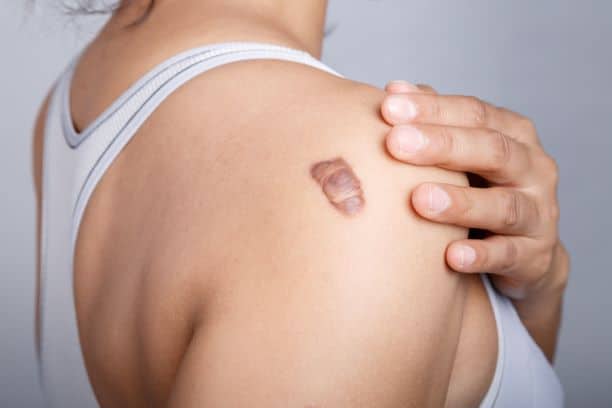Keloids are a unique type of scar tissue that can occur after an injury to the skin. Keloids can develop into large protrusions that may hang off the skin, itch, and can be a real concern for a patient’s comfort or self-esteem. According to U.S. Dermatology Partners physician, Dr. Neel Patel of Southwest Skin Specialists in Phoenix and Scottsdale, Arizona, “Hypertrophic or thick scars and keloids are not uncommon, and many patients have never even heard of them. Keloids can be easier to address when they first develop since they can grow quickly. So, an early presentation and treatment is ideal though not often the case.” In this blog, Dr. Patel walks us through basic information about keloids and shares some facts about this condition that aren’t as well known.
What are Keloids?
Scars are a natural part of the healing process after an injury to the skin. While keloids are a type of scar tissue, they can grow much larger than the wound. Once a keloid forms, it can grow over several months or even years, overshadowing the original injury. If a keloid forms near a joint or covers a large part of the body, it may impede movement or make movements painful.
What do Keloids Look Like?
Dr. Patel says, “Keloids are brownish-pink rubbery nodules or plaques that appear after surgery, an injury, a pimple, or even an ear-piercing. Most people have a personal history of thicker scars or a family history of keloids. They have a rubbery texture and can be painful.
What Causes Keloids?
Keloids occur after any injury to the skin. They typically occur in younger individuals but can occur at any age. Common circumstances include ear piercings, after surgery, and inflammatory acne on the chest or back. In response to the injury, genetically susceptible individuals develop scar tissue or collagen fibers that are larger than normal and grow beyond the boundaries of the original injury.
Facts About Keloids
Some facts about keloids that are not as well known include:
1 – Simply Removing Keloids May Lead to Larger Keloids
Because keloids are actually a type of hyper-replicating scar tissue, surgical removal needs to be performed very precisely in order to avoid creating a bigger problem. According to Dr. Patel, “A dermatologist understands the way that skin can react when a keloid is removed, and they take steps during the process to ensure the best results. We can also walk you through the best at-home care to help you reduce your risk of developing keloids again.”
2 – They are Much More Common for People with Darker Skin Tones
Dr. Patel says, “Anyone with any skin type can develop keloids, but we do see them much more frequently in those who have darker pigmented skin. A family history of keloids can also increase your risk. Additionally, age is a factor, since most people develop keloids between the ages of 10 and 30.” If any or all of these characteristics describe you, it may be a good idea to avoid situations that increase your risk of developing keloids, including piercings and tattoos.
3 – Keloids are Most Common on the Earlobes, Chest, Back & Shoulders
If you are at risk for developing keloids, you should take special care to avoid damage to the areas where keloids are most likely to develop, including the earlobes, chest, back, and shoulders. In addition to these common keloid sites, people are more likely to develop keloids at surgical sites, in areas where they are affected by a chronic skin condition like acne or psoriasis, and areas that are shaved, tweezed, or waxed regularly. There are also spontaneous keloids that develop without any obvious cause, usually on the chest or back.
4 – Keloids are Often Confused with Similar Conditions
Many patients visit us worried that they are developing keloids, but they are actually dealing with hypertrophic scars or dermatofibromas. Hypertrophic scars are large, raised areas of the skin that can be darker in color than the surrounding areas. They may grow to be quite large. However, this type of scarring is typically limited to the initially damaged area. Hypertrophic scars may grow up and thicken, but they won’t likely grow outward. Additionally, where keloids may continue to grow for months or years after they develop, hypertrophic scars usually get smaller over time. Steroid injections may help to speed the reduction of hypertrophic scars. Dermatofibromas are small, benign bumps in the skin. While they may look and feel a bit like a keloid scar, these bumps typically occur on the legs, without damage prompting their development, and they do not usually grow.
5 – Keloids are Often Associated with Piercings
While keloids can develop across the body after any type of injury or even spontaneously, they are most often associated with piercings, especially ear piercings. If you are at higher risk for keloids or have developed keloid scars in the past, you may want to rethink piercings.
Effective Keloid Treatments
In addition to cosmetic concerns, keloids can also be painful and itchy, and in some cases, they can be at risk of getting caught or otherwise damaged. Whatever your reason for wanting to have a keloid removed, your dermatologist can help.
- Injected corticosteroids – These injections are almost always used as part of a keloid removal plan. A series of injections will be used to relieve itching and other symptoms of the keloid and start to soften and shrink the scar. In most cases, corticosteroid injections alone will not permanently remove the keloid. However, pretreating the area with corticosteroid injections and retreating after surgical removal can help improve the efficacy of other keloid removal steps.
- Keloid surgery – The dermatologist will use a scalpel to remove the keloid. While surgery may seem like the fastest way to get rid of the keloid, the trauma of surgery can trigger the production of another keloid. For this reason, we will usually provide additional pre and/or post-treatment therapies to prevent the production of a new keloid scar.
- Laser treatment – For small keloids, laser treatment may be able to reduce the size of or even fully remove the scars. It may also be used after surgical removal to help reduce the risk of keloid development.
- Silicone sheets and gels – Like laser treatment, silicone can be used to reduce the size of a keloid scar on its own, and silicone gel application can also be used as part of the recovery process to prevent the return of a keloid.
- Cryotherapy – Best for very small keloids, cryotherapy freezes and reduces the size of the keloid scar from the inside out without creating further damage to the skin’s surface. Additionally, cryotherapy can improve the efficacy of other treatments, especially corticosteroid injections.
- Radiation – Radiation can be used to reduce the size of smaller keloids, and it’s also recommended after keloid removal surgery to prevent regrowth.
- Ligature – This gradual removal process is often recommended for keloids that hang from the ear lobe. For these scars, we tie a string around the base of the keloid. This string slowly places pressure, cutting into the keloid. We’ll replace the string every few weeks. This leads to the removal of the keloid without any additional trauma.
After Care to Prevent Keloid Development
Following your keloid treatment, a dermatologist will provide specific aftercare instructions to help you prevent the development or regrowth of your keloid. The most important aspect of post keloid removal care is to apply consistent pressure to the area using a dressing or compression garment. This reduces blood flow to the area and decreases the risk of keloid development. Silicone sheets or gel may also be used as part of your ongoing care plan to prevent your keloid from returning. This may sound simple enough, but it can actually be difficult for some patients to wear these dressings for the recommended time frame (12 to 24 hours a day for up to a year). While wearing the compression dressings may be challenging, it is really the best way to prevent the development of new keloids.
Visit U.S. Dermatology Partners
At U.S. Dermatology Partners, our knowledgeable dermatologists offer a range of treatments, including keloid removal. We have offices in several states, so there is likely to be a U.S. Dermatology Partners location near your hometown. To find out more and request an appointment, get started using our simple online form. We look forward to hearing from you.
Find a location near me
or


